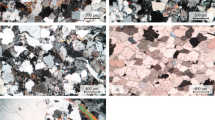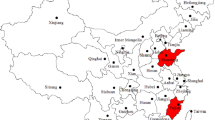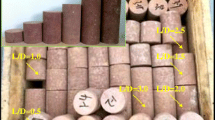Abstract
We investigated the statistical characteristics and probability distribution of the mechanical parameters of natural rock using triaxial compression tests. Twenty cores of Jinping marble were tested under each different levels of confining stress (i.e., 5, 10, 20, 30, and 40 MPa). From these full stress–strain data, we summarized the numerical characteristics and determined the probability distribution form of several important mechanical parameters, including deformational parameters, characteristic strength, characteristic strains, and failure angle. The statistical proofs relating to the mechanical parameters of rock presented new information about the marble’s probabilistic distribution characteristics. The normal and log-normal distributions were appropriate for describing random strengths of rock; the coefficients of variation of the peak strengths had no relationship to the confining stress; the only acceptable random distribution for both Young’s elastic modulus and Poisson’s ratio was the log-normal function; and the cohesive strength had a different probability distribution pattern than the frictional angle. The triaxial tests and statistical analysis also provided experimental evidence for deciding the minimum reliable number of experimental sample and for picking appropriate parameter distributions to use in reliability calculations for rock engineering.


[modified Goodman (1989)]













Similar content being viewed by others
References
ASTM (1995) Standard test method for unconfined compressive strength of intact rock core specimens. In: ASTM Committee D-18 on soil and rock, D2938-95, pp 1–3
Bagde MN (2000) An investigation into strength and porous properties of metamorphic rocks in the Himalayas: a case study. Geotech Geol Eng 18:209–219
Brady BHG, Brown ET (2004) Rock mechanics for underground mining, 3rd edn. Springer, Berlin
Brani V (2011) Statistics for bioengineering sciences. Springer, New York
Bruno G (2013) Statistical method for assessing the uniaxial compressive strength of carbonate rock by schmidt hammer tests performed on core samples. Rock Mech Rock Eng 46:199–206
Bury K (1999) Statistical distributions in engineering. Cambridge University Press, Cambridge
Cai M (2010) Practical estimates of tensile strength and Hoek–Brown strength parameter m i of brittle rocks. Rock Mech Rock Eng 43:167–184
Cai M (2011) Rock mass characterization and rock property variability considerations for tunnel and cavern design. Rock Mech Rock Eng 44:379–399
David LB, Justin TD, Kendra EM et al (2010) Detrital-zircon geochronology of the metasedimentary rocks of north-western Graham Land. Antarct Sci 22:65–78
Deng J, Bian L (2005) Estimating probability curves of rock variables using orthogonal polynomials and sample moments. J Cent South Univ Technol 12(3):349–353
Deng J, Li XB, Gu DS (2004) probability distribution of rock mechanics parameters by using maximum entropy method. Chin J Rock Mech Eng 23(13):2177–2218 (in Chinese)
Diederichsa MS, Kaiser PK, Eberhardt E (2004) Damage initiation and propagation in hard rock during tunnelling and the influence of near-face stress rotation. Int J Rock Mech Min Sci 41:785–812
Dodagoudar GR, Venkatachalam G (2000) Reliability analysis of slope using fuzzy sets theory. Comput Geotech 27:101–115
Duarte MT, Liu HY, Kou SQ et al (2005) Microstructural modeling approach applied to rock material. J Mater Eng Perform 14:104–111
Duzgun HSB, Yucemen MS, Karpuz C (2003) A methodology for reliability-based design of rock slopes. Rock Mech Rock Eng 36(2):95–120
Einstein HH, Baecher GB (1982) Probabilistic and statistical methods in engineering geology. Rock Mech 12(S):47–61
Fairhurst CE, Hudson JA (1999) Draft ISRM suggested method for the complete stress–strain curve for intact rock in uniaxial compression. Int J Rock Mech Min Sci 36:279–289
Feng XT, Hudson JA (2011) Rock engineering and design. CRC Pres, Leiden
Fossum AF, Sensen PE, Pfeifle TW, Mellegard KD (1995) Experimental determination of probability distributions for parameters of a salem limestone cap plasticity model. Mech Mater 21:119–137
Giasi CI, Masi P, Cherubini C (2003) Probabilistic and fuzzy reliability analysis of a sample slope near Aliano. Eng Geol 67:391–402
Goh ATC, Zhang W (2012) Reliability assessment of stability of underground rock caverns. Int J Rock Mech Min Sci 55:157–163
Goodman RE (1989) Introduction to rock mechanics, 2nd edn. Wiley, London
Goodman RE (1995) Block theory and its application. Geotecnique 45(3):383–423
Haldar A, Mahadevan S (2000) Probability. Reliability and statistical methods in engineering design. Wiley, New York, p 304
Hoek E (1998) Reliability of Hoek–Brown estimates of rock mass properties and their impact on design. Int J Rock Mech Min Sci 35(1):63–68
Hoek E, Brown ET (1997) Practical estimates of rock mass strength. Int J Rock Mech Min Sci 34(8):1165–1186
Hoek E, Martin CD (2014) Fracture initiation and propagation in intact rock—a review. J Rock Mech Geotech Eng 6(4):287–300
Hudson, JA, Fairhurst C (1969) Tensile strength, Weibull’s theory and a general statistical approach to rock failure. In: Proceedings of the Southampton civil engineering materials conference
ISRM (1979) Suggested methods for determining the uniaxial compressive strength and deformability of rock materials. Int J Rock Mech Min Sci Geomech Abstr 16(2):135–140
ISRM (2007) The complete ISRM suggested methods for rock characterization, testing and monitoring: 1974–2006. In: Ulusay R, Hudson JA (eds). ISRM Turkish National Group, Ankara
Jiang Q, Feng XT (2011) Intelligent stability design of large underground hydraulic caverns: Chinese method and practice. Energies 4(10):1542–1562
Karl I, Henke FL, Kaiser W (1973) Forecast on the strength and deformation characteristics of a stratified rock system based on the example of the Alb tunnel. Bull Eng Geol Environ 8:43–48
Kostak B, Bielenstein HU (1971) Strength distribution in hard rock. Int J Rock Mech Min Sci Geomech Abstr 8(5):501–521
Li XB, Gong FQ (2009) A method for fitting probability distributions to engineering properties of rock masses using Legendre orthogonal polynomials. Struct Saf 31:335–343
Liolios P, Exadaktylos G (2013) Comparison of a hyperbolic failure criterion with established failure criteria for cohesive-frictional materials. Int J Rock Mech Min Sci 63:12–26
Low BK (2007) Rliability analysis of rock slopes involving correlated nonnormals. Int J Rock Mech Min Sci 44:922–935
Maheshwari P (2009) Modified Stanley’s approach for statistical analysis of compression strength test data of rock specimens. Int J Rock Mech Min Sci 46:1154–1161
Major G, Ross-Brown D, Kim HS (1978). A general probabilistic analysis for 3-dimensional wedge failures. In: Proceedings of the 19th US symposium on rock mechanics, pp 45–51
Martin CD (1993) The strength of massive Lac du Bonnet granite around underground opening. Ph.D. thesis, p 278
Martin CD, Chandler NA (1994) The progressive fracture of Lac du Bonnet granite. Int J Rock Mech Min Sci 31(6):643–659
Martin CD, Kaiser PK, Christiansson R (2003) Stress, instability and design of underground excavations. Int J Rock Mech Min Sci 40:1027–1047
Mazzoccola DF, Millar DL, Hudson JA (1997) Information, uncertainty and decision making in site investigation for rock engineering. Geotech Geol Eng 15:145–180
Nilsen B (2000) New trend in rock slope stability analysis. Bull Eng Geol Environ 58:173–178
Nomiko PP, Sofianos AI (2011) An analytical probability distribution for the factor of safety in underground rock mechanics. Int J Rock Mech Min Sci 48:597–605
Palchik V, Hatzor YH (2002) Crack damage stress as a composite function of porosity and elastic matrix stiffness in dolomites and limestones. Eng Geol 63:233–245
Park HJ, West TR, Woo I (2005) Probabilistic analysis of rock slope stability and random properties of discontinuity parameters, Interstate Highway 40. Eng Geol 79:230–232
Park HJ, Um JG, Woo LK et al (2012) Application of fuzzy set theory to evaluate the probability of failure in rock slopes. Eng Geol 125:92–101
Park D, Kim HM, Ryu DW et al (2013) Probability-based structural design of lined rock caverns to resist high internal gas pressure. Eng Geol 153:144–151
Priest SD, Brown ET (1983) Probabilistic stability analysis of variable rock slopes. Trans Inst Min Metall A 92:1–12
Ruffolo RM, Shakoor A (2009) Variability of unconfined compressive strength in relation to number of test samples. Eng Geol 108(1):16–23
Sanchidrian JA, Ouchterlony F, Moser P et al (2012) Performance of some distributions to describe rock fragmentation data. Int J Rock Mech Min Sci 53:18–31
Sari M, Karpuz C, Ayday C (2010) Estimating rock mass properties using Monte Carlo simulation Ankara andesites. Comput Geotech 36:959–969
Saria M, Karpuz C (2006) Rock variability and establishing confining pressure levels for triaxial tests on rocks. Int J Rock Mech Min Sci 43:328–335
Sofianos AI, Nomikos PP, Papantonopoulos G (2014) Distribution of the factor of safety, in geotechnical engineering, for independent piecewise linear capacity and demand density functions. Comput Geotech 55:440–447
Tonona F, Bernardini A, Mammino A (2000) Determination of parameters range in rock engineering by means of random set theory. Reliab Eng Syst Saf 70:241–261
Wiles TD (2006) Reliability of numerical modelling predictions. Int J Rock Mech Min Sci 43:454–472
Wong TF, Wong RH, Chau K et al (2006) Microcrack statistics, Weibull distribution and micromechanical modeling of compressive failure in rock. Mech Mater 38:664–681
Yamaguchi U (1970) The number of test-pieces required to determine the strength of rock. Int J Rock Mech Min Sci 7:209–227
Yang SQ, Jing HW, Wang SY (2012) Experimental investigation on the strength, deformability failure behavior and acoustic emission locations of red. Rock Mech Rock Eng 45:583–606
Acknowledgments
The authors gratefully acknowledge the financial support from the State Key Research Development Program of China (Grant No. 2016YFC0600707), the National Natural Science Foundation of China (Grant Nos. 41172284 and 51379202) and the Youth Innovation Promotion Association (Grant No. 2013215). In particular, authors would also like to thank the reviewer for his valuable suggestions.
Author information
Authors and Affiliations
Corresponding author
Rights and permissions
About this article
Cite this article
Jiang, Q., Zhong, S., Cui, J. et al. Statistical Characterization of the Mechanical Parameters of Intact Rock Under Triaxial Compression: An Experimental Proof of the Jinping Marble. Rock Mech Rock Eng 49, 4631–4646 (2016). https://doi.org/10.1007/s00603-016-1054-5
Received:
Accepted:
Published:
Issue Date:
DOI: https://doi.org/10.1007/s00603-016-1054-5




